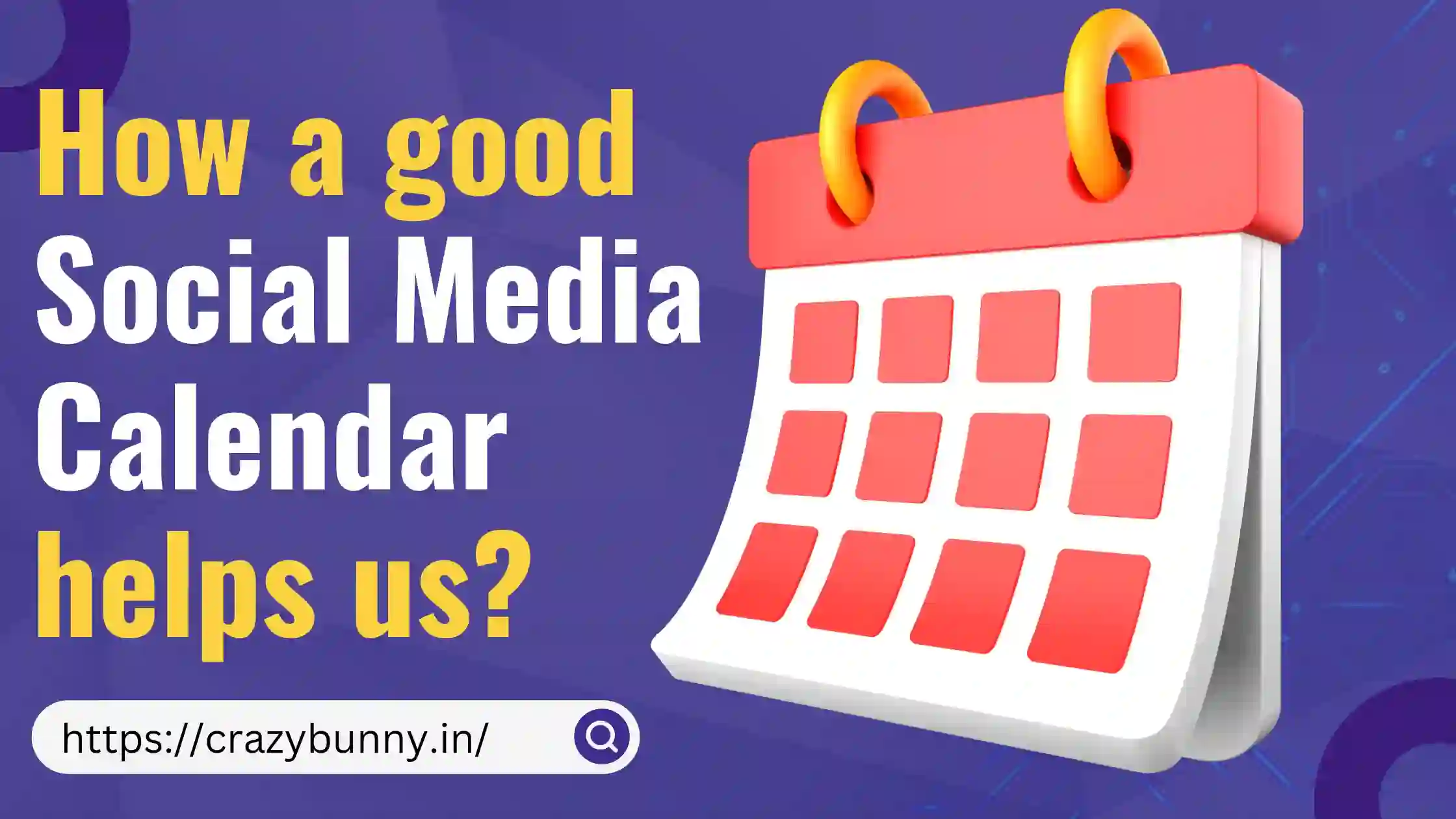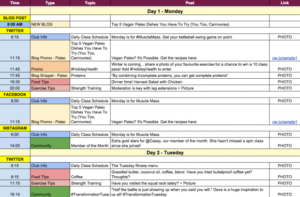Social Media Calendar can Help us to bring Check on our Work.
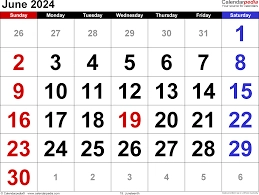
In today’s digital age, social media has become an indispensable tool for businesses, influencers, and individuals alike. The ability to connect with a global audience in real-time presents an unparalleled opportunity for growth, engagement, and brand development. However, navigating the myriad of social media platforms and maintaining a consistent, effective presence can be daunting. This is where a well-structured social media calendar comes into play.
A social media calendar is not just a schedule of posts; it is a strategic framework that guides your content creation, distribution, and engagement efforts. By meticulously planning and organising your social media activities, a calendar helps ensure that your messaging is cohesive, timely, and aligned with your overarching goals.
The advantages of using a social media calendar are manifold. It streamlines your workflow, enhances content quality, boosts engagement, and provides valuable insights into your audience’s preferences and behaviours. In this article, we will delve into the multifaceted benefits of a social media calendar, explore its essential components, and offer practical steps to create and maintain an effective calendar. We will also highlight real-world examples of successful social media strategies and examine the tools that can facilitate your social media planning. Finally, we will address common challenges and look ahead to emerging trends in social media management.
In today’s fast-paced digital world, social media is a powerful tool for businesses and individuals alike. But with so many platforms and constant content demands, keeping your social media presence organised and effective can be a challenge. Enter the social media calendar – your secret weapon for conquering content creation and maximising engagement.
Understanding a Social Media Calendar
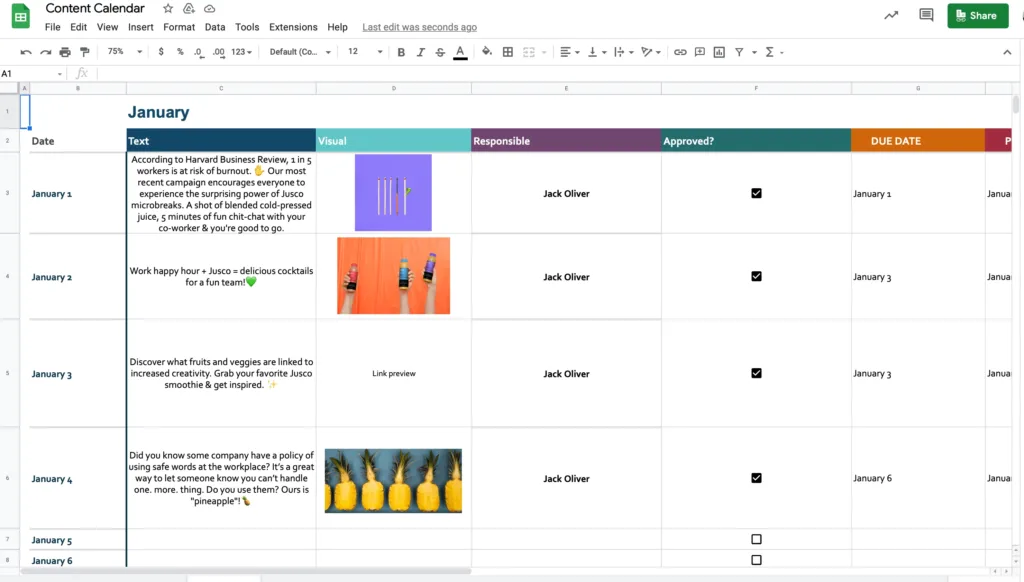
Definition
A social media calendar is a strategic tool used to plan and organise content across various social media platforms. It outlines what content will be posted, when it will be posted, and on which platforms, providing a clear roadmap for social media managers and marketers.
Purpose
The primary purpose of a social media calendar is to ensure a consistent and cohesive presence on social media. It helps in managing time effectively, avoiding last-minute rushes, and ensuring that content aligns with marketing campaigns and business objectives.
Why You Need a Social Media Calendar
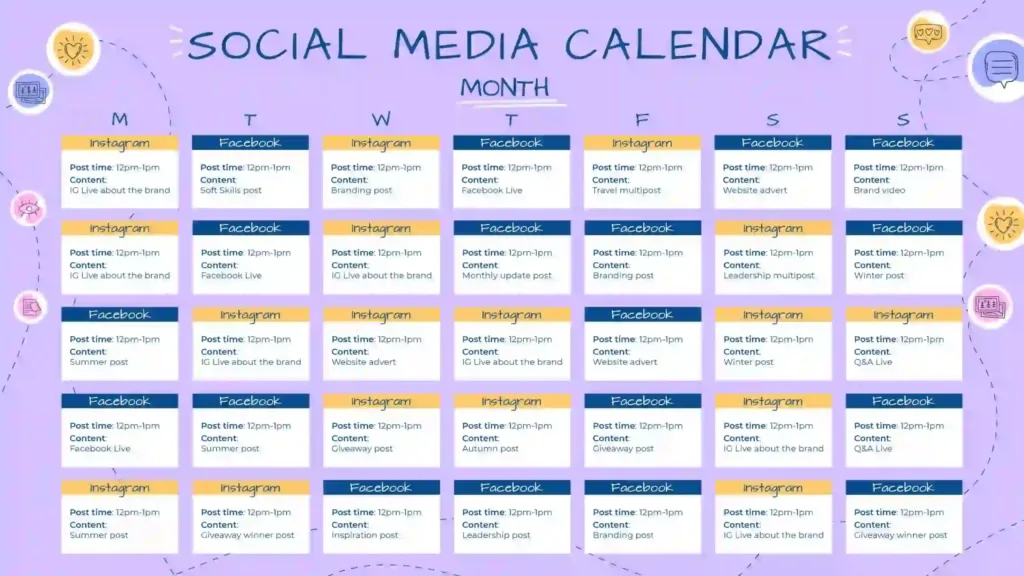
Imagine scrambling to create a post right before you need to publish. No clear strategy, no high-quality visuals – just a rushed attempt to fill the void. A social media calendar eliminates this stressful scenario. Here’s how:
-
Saves Time and Enhances Efficiency:
Planning your content in advance allows you to batch create, schedule posts, and free up valuable time for other crucial tasks.
-
Boosts Consistency:
Regular posting with a consistent brand voice builds trust and familiarity with your audience. Social media calendars ensure a steady flow of content, keeping your brand at the forefront of your audience’s mind.
-
Strategic Planning:
Integrate industry trends, holidays, and special events into your calendar. This allows you to capitalise on opportunities and ride the wave of trending topics.
-
Collaboration Made Easy:
Working with a team? A shared calendar keeps everyone on the same page, fostering seamless collaboration and content creation.
-
Analyses Performance:
Track the success of your posts and identify what resonates with your audience. Use this data to refine your strategy and create even more engaging content in the future.
Benefits of a Social Media Calendar
Improved Organization
Having a social media calendar improves overall organisation by providing a clear view of your content strategy. It helps in visualising the flow of content, ensuring that there are no gaps and that the content is well-distributed across all platforms.
Consistent Posting
Consistency is key to maintaining an engaged audience. A social media calendar ensures that you post regularly, keeping your audience interested and engaged with fresh and relevant content.
Better Content Planning
With a social media calendar, you can plan your content well in advance. This allows for more thoughtful and creative content creation, aligning with holidays, events, and promotional campaigns.
Enhanced Engagement
By scheduling posts at optimal times when your audience is most active, a social media calendar can enhance engagement rates. It also allows for timely responses to trends and events, increasing interaction with your audience.
Performance Tracking
A social media calendar aids in tracking the performance of your posts and campaigns. By analysing metrics, you can adjust your strategy to better meet your goals and improve your social media ROI.
Components of an Effective Social Media Calendar
Content Categories
Organising your content into categories such as promotional, educational, and entertaining ensures a balanced mix that keeps your audience engaged and prevents monotony.
Posting Schedule
A detailed posting schedule outlines the frequency and timing of your posts, tailored to each platform’s best practices and your audience’s behaviour patterns.
Content Themes and Campaigns
Planning content around themes and campaigns helps in creating a cohesive narrative and aligning your social media efforts with broader marketing goals.
Responsible Personnel
Assigning specific roles and responsibilities ensures that every aspect of your social media strategy is covered, from content creation to posting and engagement.
Performance Metrics
Including performance metrics in your calendar allows you to track the success of your posts and campaigns, providing insights for continuous improvement.
Building a Winning Social Media Calendar:
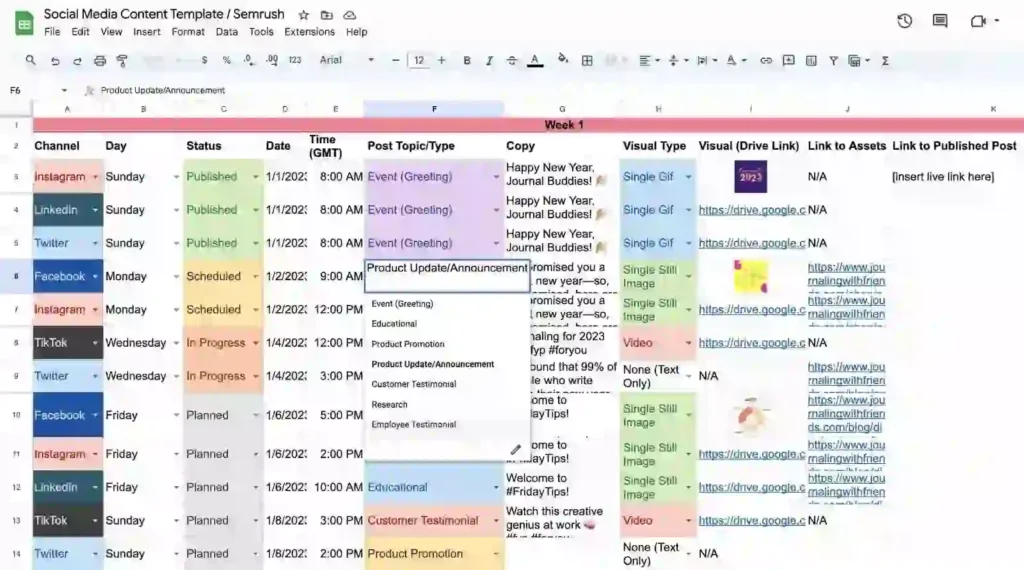
Now that you understand the power of a social media calendar, let’s explore how to build one that works for you:
- Define Your Goals: What do you hope to achieve with your social media presence? Brand awareness, increased sales, or community building? Aligning your goals with your content strategy is crucial.
- Know Your Audience: Who are you trying to reach? Understanding their demographics, interests, and preferred platforms helps tailor content that resonates.
- Choose Your Platforms: Don’t spread yourself too thin. Focus on the platforms where your target audience resides.
- Content Variety is Key: Experiment with different content formats to keep your audience engaged. Images, videos, infographics, and even live sessions can all play a role.
- Schedule and Automate: Take advantage of scheduling tools offered by most social media platforms or third-party scheduling software. This frees you up from manual posting and ensures consistent content flow.
Beyond the Basics: Advanced Calendar Strategies
A good social media calendar is a living document that evolves with your needs. Here are some advanced strategies to consider:
- Curate Compelling Content: Don’t just create, curate! Share valuable content from industry experts and influencers to establish yourself as a thought leader.
- Run Contests and Giveaways: Generate excitement and user-generated content with interactive campaigns.
- Respond and Engage: Social media is a two-way street. Regularly monitor comments and messages, and respond promptly to foster a sense of community.
- Track and Analyze: Use social media analytics to measure the performance of your content. Analyse what works and adjust your strategy accordingly.
Leveraging Special Days and Festivals

One of the most compelling aspects of a social media calendar is its ability to help you leverage special days and festivals to engage with your audience. Here’s how:
- Increased Reach: Special days and festivals often generate heightened social media activity as users share their experiences and sentiments. By participating in these conversations, you can extend your reach and connect with a broader audience.
- Relevance: Aligning your content with specific occasions demonstrates your brand’s awareness and relatability. Whether it’s celebrating cultural holidays or acknowledging industry milestones, relevance fosters deeper connections with your audience.
- Trending Hashtags: Special days and festivals are accompanied by trending hashtags that can amplify your reach and visibility. By incorporating these hashtags into your posts, you increase the likelihood of being discovered by users searching for related content.
- Emotional Connection: Festivals evoke emotions and nostalgia, making them powerful catalysts for engagement. By tapping into these sentiments, you can create content that resonates on a personal level, fostering stronger connections with your audience.
Crafting Effective Festival Posts

While participating in festivals and special days can yield significant benefits, it’s essential to approach them thoughtfully. Here are some strategies for crafting effective festival posts:
- Research and Planning: Identify the festivals and special days that align with your brand values and target audience. Conduct research to understand the significance of each occasion and how it’s celebrated.
- Authenticity: Authenticity is key to resonating with your audience. Instead of merely capitalizing on trending topics, find genuine ways to connect your brand’s message with the spirit of the festival.
- Visual Storytelling: Utilize visual content such as images, videos, and graphics to convey your message effectively. Visual storytelling is particularly impactful on social media platforms and can capture attention in a crowded feed.
- Engagement Opportunities: Encourage participation and engagement from your audience by hosting contests, polls, or interactive challenges related to the festival. This not only increases interaction but also fosters a sense of community around your brand.
- Consistent Branding: While adapting your content to fit the festival theme, ensure that it remains consistent with your brand identity. Maintain a cohesive aesthetic and tone across all posts to reinforce brand recognition.
Facts and Figures
Industry Statistics
- According to a survey by HubSpot, 72% of marketers who use a social media calendar report that it has significantly improved their content marketing strategy.
- A report by CoSchedule indicates that marketers who document their strategy are 313% more likely to report success than those who do not.
- Buffer’s research shows that consistent posting can increase engagement rates by up to 150%.
Case Studies
- Case Study 1: A small business increased its social media engagement by 200% within six months by implementing a social media calendar.
- Case Study 2: A major brand saw a 50% increase in website traffic from social media after adopting a more structured posting schedule through a social media calendar.
Companies that Make Social Media Calendars
Overview of Tools and Platforms
Several companies offer tools to help manage social media calendars, each with unique features designed to simplify the planning and scheduling process.
Key Features
- Hootsuite: Offers a visual calendar for scheduling posts, along with analytics and team collaboration features.
- Buffer: Provides a straightforward scheduling tool, content suggestions, and performance analysis.
- CoSchedule: Combines social media scheduling with a full marketing calendar, allowing for integrated campaign planning.
Pros and Cons
- Hootsuite:
- Pros: Comprehensive features, supports multiple platforms, robust analytics.
- Cons: Can be expensive for small businesses, complex interface for beginners.
- Buffer:
- Pros: Easy to use, affordable, great for small to medium businesses.
- Cons: Limited features compared to competitors, basic analytics.
- CoSchedule:
- Pros: Integrated with other marketing tools, excellent for team collaboration.
- Cons: Higher cost, more suited for larger teams.
How a Social Media Calendar Helps Companies
Case Study: Company A
Company A, a mid-sized e-commerce business, implemented a social media calendar to organise their promotional content around key sales periods. Within three months, they saw a 40% increase in sales attributed to more consistent and targeted social media posts.
Case Study: Company B
Company B, a tech startup, used a social media calendar to coordinate product launches and updates. This structured approach led to a 25% increase in user engagement and a 15% boost in new customer acquisition.
Lessons Learned
- Planning ahead allows for more strategic content creation and distribution.
- Consistency in posting builds trust and engagement with the audience.
- Tracking performance helps in refining and improving the social media strategy over time.
Components of an Effective Social Media Calendar
Content Categories
Organizing your content into categories such as promotional, educational, and entertaining ensures a balanced mix that keeps your audience engaged and prevents monotony.
Posting Schedule
A detailed posting schedule outlines the frequency and timing of your posts, tailored to each platform’s best practices and your audience’s behaviour patterns.
Content Themes and Campaigns
Planning content around themes and campaigns helps in creating a cohesive narrative and aligning your social media efforts with broader marketing goals.
Responsible Personnel
Assigning specific roles and responsibilities ensures that every aspect of your social media strategy is covered, from content creation to posting and engagement.
Performance Metrics
Including performance metrics in your calendar allows you to track the success of your posts and campaigns, providing insights for continuous improvement.
Steps to Create a Social Media Calendar
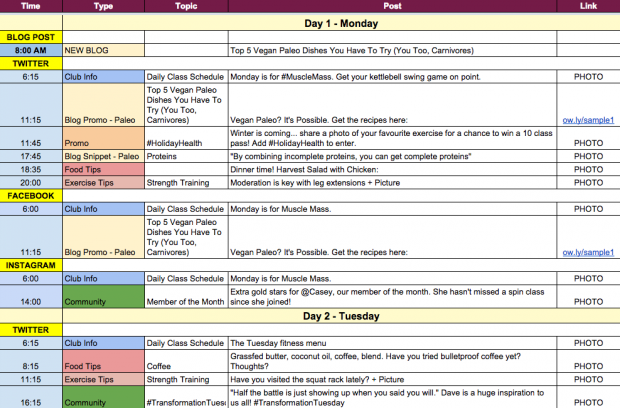
Define Your Goals
Start by defining what you want to achieve with your social media efforts. Goals can range from increasing brand awareness to driving website traffic or boosting sales.
Identify Your Audience
Understanding your audience is crucial for creating relevant and engaging content. Identify their demographics, interests, and behaviours to tailor your content accordingly.
Choose Your Platforms
Select the social media platforms that best align with your audience and business goals. Each platform has its own strengths and user base, so choose wisely.
Plan Your Content
Develop a content plan that includes a mix of promotional, educational, and entertaining posts. Ensure that your content aligns with your overall marketing strategy.
Schedule Your Posts
Use your social media calendar to schedule posts at optimal times. Consistency is key, so ensure that you maintain a regular posting schedule.
Tools and Software for Managing Social Media Calendars
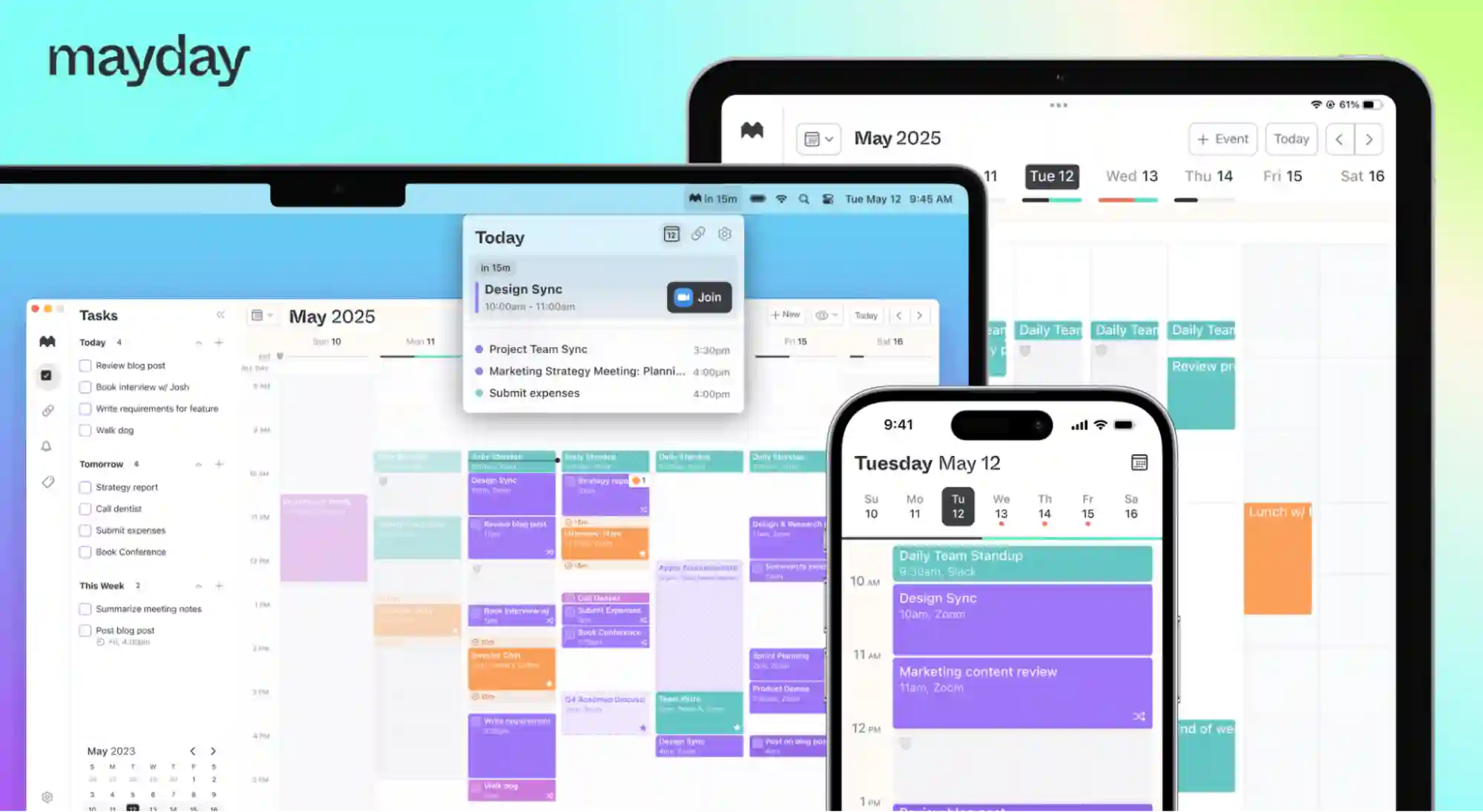
Popular Tools (e.g., Hootsuite, Buffer)
- Hootsuite: Offers a comprehensive suite of tools for scheduling, analytics, and team collaboration.
- Buffer: Known for its user-friendly interface and straightforward scheduling capabilities.
- CoSchedule: Combines social media scheduling with a full marketing calendar, ideal for integrated campaign planning.
Features to Look For
- Ease of use: The tool should be intuitive and easy to navigate.
- Integration: Ability to integrate with other marketing tools and platforms.
- Analytics: Robust analytics to track the performance of your posts and campaigns.
- Collaboration: Features that facilitate team collaboration and approval workflows.
Pros and Cons
- Hootsuite:
- Pros: Comprehensive features, supports multiple platforms, robust analytics.
- Cons: Can be expensive for small businesses, complex interface for beginners.
- Buffer:
- Pros: Easy to use, affordable, great for small to medium businesses.
- Cons: Limited features compared to competitors, basic analytics.
- CoSchedule:
- Pros: Integrated with other marketing tools, excellent for team collaboration.
- Cons: Higher cost, more suited for larger teams.
Challenges in Maintaining a Social Media Calendar
Common Issues
- Time Management: Keeping up with a consistent posting schedule can be time-consuming.
- Content Quality: Maintaining high-quality content consistently can be challenging.
- Engagement: Ensuring that your audience remains engaged requires continuous effort and creativity.
Solutions and Best Practices
- Automation: Use scheduling tools to automate posts and save time.
- Content Planning: Plan content well in advance to avoid last-minute rushes.
- Performance Analysis: Regularly analyse performance metrics to refine your strategy and improve engagement.
Future Trends in Social Media Planning

Automation
Automation tools are becoming increasingly sophisticated, allowing for more efficient scheduling and posting.
AI and Machine Learning
AI and machine learning are being used to analyse audience behaviour and predict the best times to post, as well as to generate content ideas.
Predictive Analytics
Predictive analytics can help in forecasting trends and planning content that is more likely to resonate with your audience.
Conclusion
A good social media calendar is an essential tool for any business or individual looking to maximise their impact on social media. It provides a structured approach to content creation, distribution, and engagement, ensuring that your social media efforts are consistent, cohesive, and aligned with your overall goals. By planning and organising your social media activities, you can streamline workflows, enhance content quality, boost engagement, and gain valuable insights into your audience’s preferences and behaviours.
A well-crafted social media calendar is your roadmap to social media success. By implementing the strategies outlined above, you can streamline your workflow, create high-quality content, and achieve your social media goals. Remember, consistency is key. So, grab your favorite calendar tool, plan your content, and watch your social media presence flourish!
In conclusion, a well-planned social media calendar is an invaluable tool for maximizing your online presence and engaging with your audience effectively. By strategically leveraging special days and festivals, you can tap into trending conversations, broaden your reach, and foster deeper connections with your audience. Remember to approach festival posts with authenticity, creativity, and relevance to ensure meaningful engagement and long-term brand loyalty. With a proactive approach to social media planning, you’ll not only avoid missing out on opportunities but also position your brand for sustained growth and success in the digital landscape.

